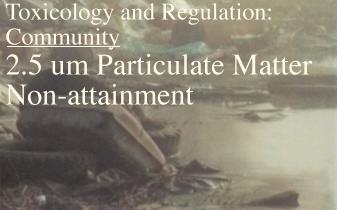Community |
||||||
Environmental |
||||||
Occupational |
||
CALENDAR |
||||||||||||||

Prior to 1997 the Clean Air Act (CAA) controlled only coarse particulate matter (PM; 10 microns or less) as one of the priority air pollutants that must be controlled for public health (others include nitrogen and sulfur oxides, ozone, carbon monoxide and polyaromatic hyrdrocarbons or PAHs). Research had shown that the smaller particulars were the ones that caused the greatest danger to people because of deeper penetration into the respiratory tract and to the level of the alveolar air sacs. Also, chemicals adsorb onto these particles and they become carriers into the body and tissues. The smaller particular size has proportionately more surface area compared to larger particle size; that is if it takes a number of small particles to equal the mass of one larger particle, the total surface area of those small particles will be greater than the surface area of the one large particle--a greater proportion of the larger particle is 'inside'. It is the surface area that is the site of adsorbption of other chemicals and of interaction with body tissues. Additionally, the smaller particles are not filtered out in the nose or upper respiratory tract and their greater velocity means they can penetrate more deeply.
In 1997 U.S. EPA added fine particulate matter (FPM) as a priority chemical to be controlled under the CAA. Control means that emissions from industry and from cars, the two main sources of the priority pollutants, had to average less than a certain amount over a three month period and over a one year period.
Only recently, however, after many delays, is EPA finally enforcing these laws, by determining which communities are out of compliance and giving them a deadline for coming into compliance. This includes both industry making necessary changes and planning of new roads and communities--which only increases particulate emissions--planned in such a way as to not add more to the areas out of compliance.
Twenty nine states, including most western states were found to be in total compliance, plus the Virgin Islands and Puerto Rico. Counties in twenty-one states were found non attainment. Approximately twelve petitions were made by either a state or country to remove that county from non attainment. All were turned down. These areas must now work to reach attainment.
See also:

